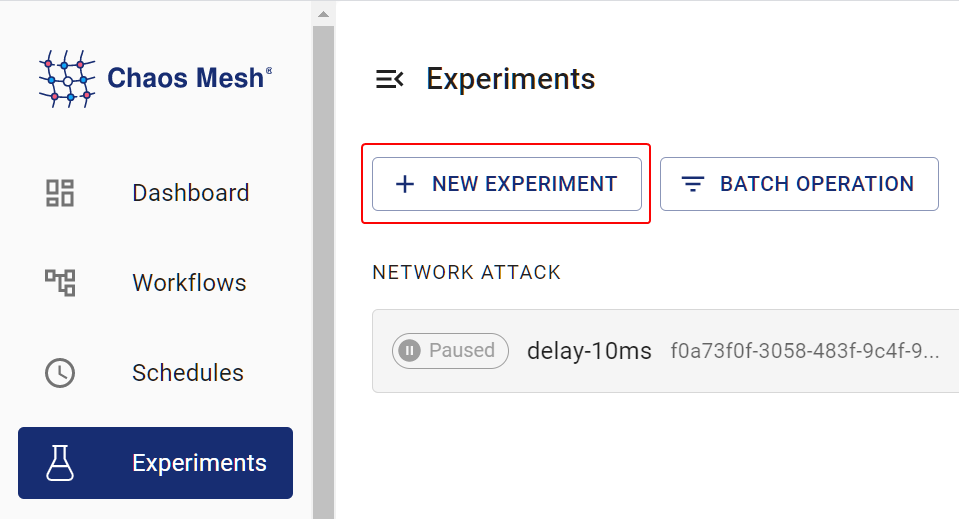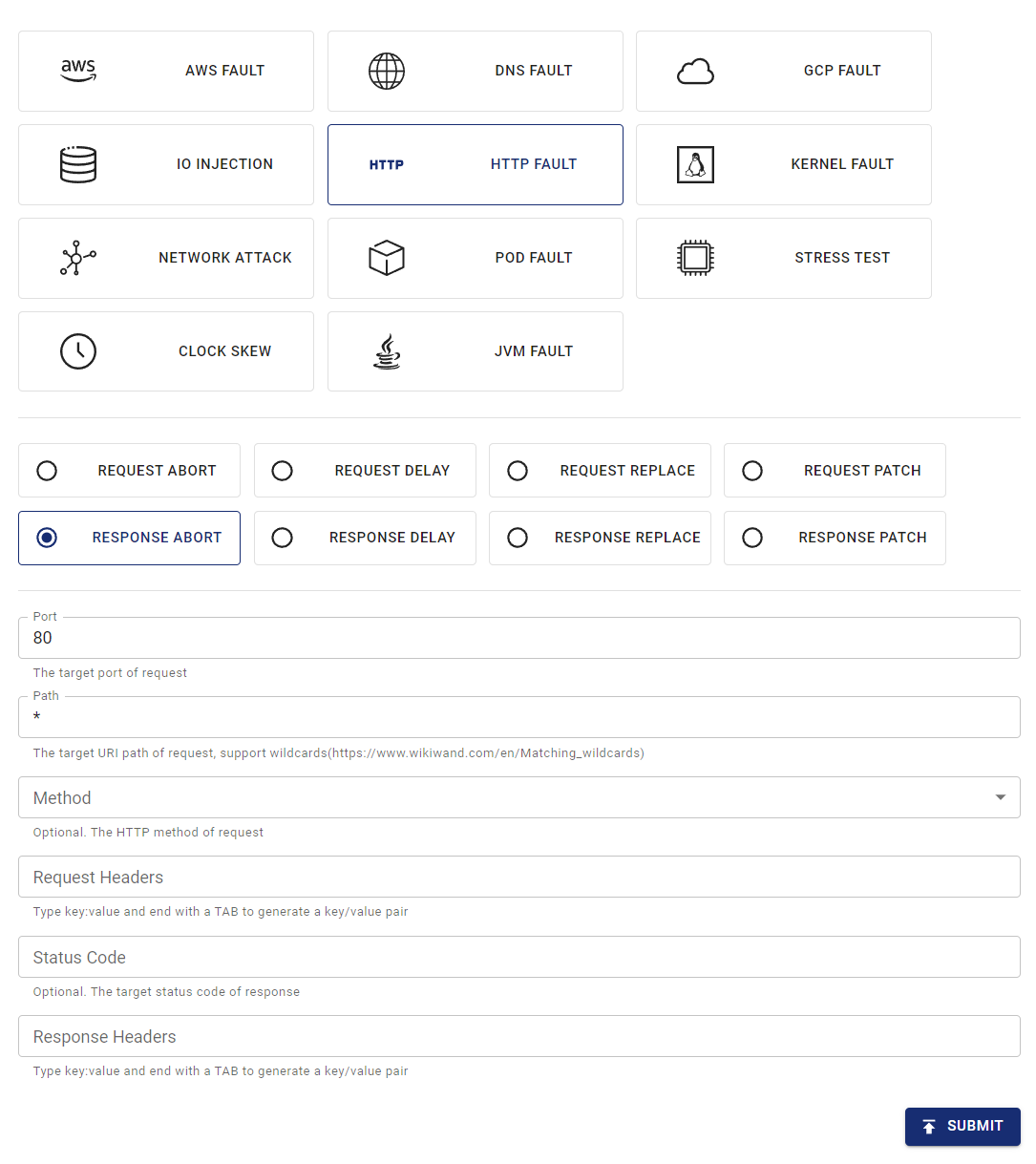Simulate HTTP Faults
This document describes how to simulate HTTP faults by creating HTTPChaos experiments in Chaos Mesh.
HTTPChaos introduction
HTTPChaos is a fault type provided by Chaos Mesh. By creating HTTPChaos experiments, you can simulate the fault scenarios during the HTTP request and response processing. Currently, HTTPChaos supports simulating the following fault types:
abort: interrupts the connectiondelay: injects latency into the request or responsereplace: replaces part of content in HTTP request or response messagespatch: adds additional content to HTTP request or response messages
HTTPChaos supports combinations of different fault types. If you have configured multiple HTTP fault types at the same time when creating HTTPChaos experiments, the order set to inject the faults when the experiments start running is abort -> delay -> replace -> patch. When the abort fault cause short circuits, the connection will be directly interrupted.
For the detailed description of HTTPChaos configuration, see Field description below.
Notes
Before injecting the faults supported by HTTPChaos, note the followings:
- There is no control manager of Chaos Mesh running on the target Pod.
- The rules will affect both of clients and servers in the Pod, if you want to affect only one side, please refer to the specify side section.
- HTTPS accesses should be disabled, because injecting HTTPS connections is not supported currently.
- For HTTPChaos injection to take effect, the client should avoid reusing TCP socket. This is because HTTPChaos does not affect the HTTP requests that are sent via TCP socket before the fault injection.
- Use non-idempotent requests (such as most of the POST requests) with caution in production environments. If such requests are used, the target service may not return to normal status by repeating requests after the fault injection.
Create experiments using Chaos Dashboard
Open Chaos Dashboard, and click NEW EXPERIMENT on the page to create a new experiment:

In the Choose a Target area, choose HTTP FAULT and select a specific behavior, such as
RESPONSE ABORT. Then fill out specific configurations.
Submit the experiment.
In the example above, you have configured injecting the "Response abort" fault into all requests of Port 80.
Create experiments using YAML files
Chaos Mesh also supports using YAML configuration files to create HTTPChaos experiments. In a YAML file, you can simulate either one HTTP fault type or a combination of different HTTP fault types.
Example of abort
Write the experimental configuration to the
http-abort-failure.yamlfile as the example below:apiVersion: chaos-mesh.org/v1alpha1
kind: HTTPChaos
metadata:
name: test-http-chaos
spec:
mode: all
selector:
labelSelectors:
app: nginx
target: Request
port: 80
method: GET
path: /api
abort: true
duration: 5mBased on this configuration example, Chaos Mesh will inject the
abortfault into the specified pod for 5 minutes. During the fault injection, the GET requests sent through port 80 in the/apipath of the target Pod will be interrupted.After the configuration file is prepared, use
kubectlto create the experiment:kubectl apply -f ./http-abort-failure.yaml
Example of fault combinations
Write the experimental configuration to
http-failure.yamlfile as the example below:apiVersion: chaos-mesh.org/v1alpha1
kind: HTTPChaos
metadata:
name: test-http-chaos
spec:
mode: all
selector:
labelSelectors:
app: nginx
target: Request
port: 80
method: GET
path: /api/*
delay: 10s
replace:
path: /api/v2/
method: DELETE
patch:
headers:
- ['Token', '<one token>']
- ['Token', '<another token>']
body:
type: JSON
value: '{"foo": "bar"}'
duration: 5mBased on this configuration example, Chaos Mesh will inject the
delayfault,replacefault, andpatchfault consecutively.After the configuration file is prepared, use
kubectlto create the experiment:kubectl apply -f ./http-failure.yaml
Field description
Description for common fields
Common fields are meaningful when the target of fault injection is Request or Response.
| Parameter | Type | Description | Default value | Required | Example |
|---|---|---|---|---|---|
mode | string | Specifies the mode of the experiment. The mode options include one (selecting a random pod), all (selecting all eligible pods), fixed (selecting a specified number of eligible pods), fixed-percent (selecting a specified percentage of Pods from the eligible pods), and random-max-percent (selecting the maximum percentage of Pods from the eligible pods). | yes | one | |
value | string | Provides parameters for the mode configuration depending on the value of mode. | no | 1 | |
target | string | Specifies whether the target of fault injuection is Request or Response. The target-related fields should be configured at the same time. | yes | Request | |
port | int32 | The TCP port that the target service listens on. | yes | 80 | |
path | string | The URI path of the target request. Supports Matching wildcards. | Takes effect on all paths by default. | no | /api/* |
method | string | The HTTP method of the target request method. | Takes effect for all methods by default. | no | GET |
request_headers | map[string]string | Matches request headers to the target service. | Takes effect for all requests by default. | no | Content-Type: application/json |
abort | bool | Indicates whether to inject the fault that interrupts the connection. | false | no | true |
delay | string | Specifies the time for a latency fault. | 0 | no | 10s |
replace.headers | map[string]string | Specifies the key pair used to replace the request headers or response headers. | no | Content-Type: application/xml | |
replace.body | []byte | Specifies request body or response body to replace the fault (Base64 encoded). | no | eyJmb28iOiAiYmFyIn0K | |
patch.headers | [][]string | Specifies the attached key pair of the request headers or response headers with patch faults. | no | - [Set-Cookie, one cookie] | |
patch.body.type | string | Specifies the type of patch faults of the request body or response body. Currently, it only supports JSON. | no | JSON | |
patch.body.value | string | Specifies the fault of the request body or response body with patch faults. | no | {"foo": "bar"} | |
duration | string | Specifies the duration of a specific experiment. | yes | 30s | |
scheduler | string | Specifies the scheduling rules for the time of a specific experiment. | no | 5 * * * * |
When creating experiments with YAML files,
replace.bodymust be the base64 encoding of the replacement content.When creating experiments with the Kubernetes API, there is no need to encode the replacement content, just convert it to
[]byteand put it into thehttpchaos.Spec.Replace.Bodyfield. The following is an example:
httpchaos.Spec.Replace.Body = []byte(`{"foo": "bar"}`)
Description for target-related fields
Request-related fields
The Request field is a meaningful when the target set to Request during the fault injection.
| Parameter | Type | Description | Default value | Required | Example |
|---|---|---|---|---|---|
replace.path | string | Specifies the URI path used to replace content. | no | /api/v2/ | |
replace.method | string | Specifies the replaced content of the HTTP request method. | no | DELETE | |
replace.queries | map[string]string | Specifies the replaced key pair of the URI query. | no | foo: bar | |
patch.queries | [][]string | Specifies the attached key pair of the URI query with patch faults. | no | - [foo, bar] |
Respond-related fields
The Response is a meaningful when the target set to Response during the fault injection.
| Parameter | Type | Description | Default value | Required | Example |
|---|---|---|---|---|---|
code | int32 | Specifies the status code responded by target. | Takes effect for all status codes by default. | no | 200 |
response_headers | map[string]string | Matches request headers to target. | Takes effect for all responses by default. | no | Content-Type: application/json |
replace.code | int32 | Specifies the replaced content of the response status code. | no | 404 |
Specify side
The rules will affect both of clients and servers in the Pod by default, but you can affect only one side by selecting the request headers.
This section provides some examples to specify the affected side, you can adjust the header selector in rules depend on your particular cases.
Client side
To inject faults into clients in the Pod without affecting servers, you can select the request/response by the Host header in the request.
For example, if you want to interrupt all requests to http://example.com/, you can apply the following YAML config:
apiVersion: chaos-mesh.org/v1alpha1
kind: HTTPChaos
metadata:
name: test-http-client
spec:
mode: all
selector:
labelSelectors:
app: some-http-client
target: Request
port: 80
path: '*'
request_headers:
Host: 'example.com'
abort: true
Server side
To inject faults into servers in the Pod without affecting clients, you can also select the request/response by the Host header in the request.
For example, if you want to interrupt all requests to your server behind service nginx.nginx.svc, you can apply the following YAML config:
apiVersion: chaos-mesh.org/v1alpha1
kind: HTTPChaos
metadata:
name: test-http-server
spec:
mode: all
selector:
labelSelectors:
app: nginx
target: Request
port: 80
path: '*'
request_headers:
Host: 'nginx.nginx.svc'
abort: true
In other cases, especially when injecting the inbound request from outside, you may select the request/response by the X-Forwarded-Host header in the request.
For example, if you want to interrupt all requests to your server behind a public gateway nginx.host.org, you can apply the following YAML config:
apiVersion: chaos-mesh.org/v1alpha1
kind: HTTPChaos
metadata:
name: test-http-server
spec:
mode: all
selector:
labelSelectors:
app: nginx
target: Request
port: 80
path: '*'
request_headers:
X-Forwarded-Host: 'nginx.host.org'
abort: true
Local debugging
If you are not sure of the effects of certain fault injections, you can also test the corresponding features locally using rs-tproxy. Chaos Mesh also provides HTTPChaos by using rs-tproxy.